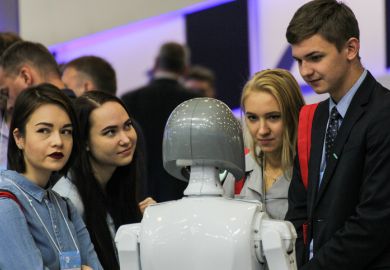Augmented reality, sensor technology and crowdsourcing are among the technologies that our panel forecast could revolutionise how the sector operates. Do you agree? Comment below the story, or tweet us @timeshighered with your suggestions.
Expert: Matthew Ramirez, lead augmented reality developer and project manager for Mimas, a centre of excellence that develops technology to make information more accessible, based at the University of Manchester
“Augmented reality (AR) is likely to have a big impact on higher education and the entire student cohort, especially when it comes to inter-professional education (IPE).
“Take medical or healthcare studies, for example: there are a number of important procedures that medical, pharmacy, nursing and dentistry students need to be able to demonstrate as part of their practical assessments.
“Currently students have limited time with experts, who may demonstrate to them how to apply a cannula and IV solution or take an electrocardiography reading.
“With AR, it is possible for students to access 3D objects, supporting media and overlaid virtual imagery, reinforcing these practical skills.
“It will also enable students to study more independently, bolstered by ready access to personal devices. AR has already been adopted with great effect by the automotive industry and other commercial operations.
“With the clear benefits of enhancing students’ professional abilities and remedying the limited face-to-face time with specialists, I predict that AR will become a common feature in universities over the next few years.”
Martin Hall, vice chancellor of Salford University and chair of Jisc:
“What we are seeing, I think, is a move from information technology as a platform for curriculum delivery to ‘virtual thinking’ being at the heart of learning and skills development.
“This is a major paradigm shift, which is why a vibrant and collaborative digital futures focus will be important across the whole of higher and further education.”
Rachel Bruce, director of technology innovation at Jisc:
“Improved sensor technology is likely to play a more prominent role in higher education, with the ability to collect more complex data on environment, wildlife, and people, with regards motions, position, temperature, sound, light and electromagnetic fields.
“We can see the combination of sensors and mobile technology evident in our everyday lives; for instance when your smartphone screen adjusts its position according to how you are holding it.
“The ability to collect and receive data via the improved sensor technology in mobile devices will have huge implications for research.
“These innovations are already happening. For example, Batmobile, a Jisc project developed at the University of Bristol, has discovered a way to easily record sound waves and detect the various bat noises.
“Developments in this technology using big data include Square Kilometre Array (SKA), the world largest radio telescope which will collect the equivalent of 1,000,000 64GB iPad’s worth of data from space every day.
“These changes will improve research and opportunities for analytics to discover new things. But with it comes the challenges of processing data, storing data, and issues of privacy at scales not known before.
“Working collaboratively on these challenges and opportunities is essential so UK research (and knock on effects to learning) remains ahead.”
Mike Howe, chief curator at the National Geological Repository, British Geological Survey:
“As more and more resources, data and information become digitised and available online, I believe the use of 3D printing will expand in higher education and research.
“Currently the British Geological Survey has worked with Jisc on a project that has created the world’s first 3D virtual fossil collection.
“As a result, it is now possible for people to access, download and print thousands of 3D digital fossil models as well as view tens of thousands of quality images and resources.
“As a curator, I get a lot of requests from academics for models of fossils to study and for teaching, which can be time consuming. 3D printing will make this process much more efficient. It is still very much in the early stages, but as more data and resources are digitised and once the cost comes down, I envisage 3D printing will become prevalent in universities to enhance research, and as a way of engaging students.”
Andy McGregor, deputy chief innovation officer at Jisc:
“Crowdsourcing involvement in research is not a new phenomenon - many people will remember the screensaver that allowed the Search for Extra Terrestrial Intelligence project to use spare computing power. But it does seem to be entering an even more productive phase by incorporating techniques from video games.
“A recent example is Foldit which presents gamers with proteins, and challenges them to fold the structure of the protein. Researchers then evaluate the highest scoring folds to see if they result in new proteins that can be used in medicine.
“Foldit is only one of many examples of this approach. There is no reason to think that the potential offered by incorporating gaming approaches is limited to science or to research.
“Most students and researchers now carry around a powerful gaming device in the form of their smart phone, and simple games are relatively easy to develop. It is easy to imagine gaming techniques being used in many different aspects of education over the next few years.”
The Jisc Digital Festival takes place in Birmingham on 11 and 12 March.




